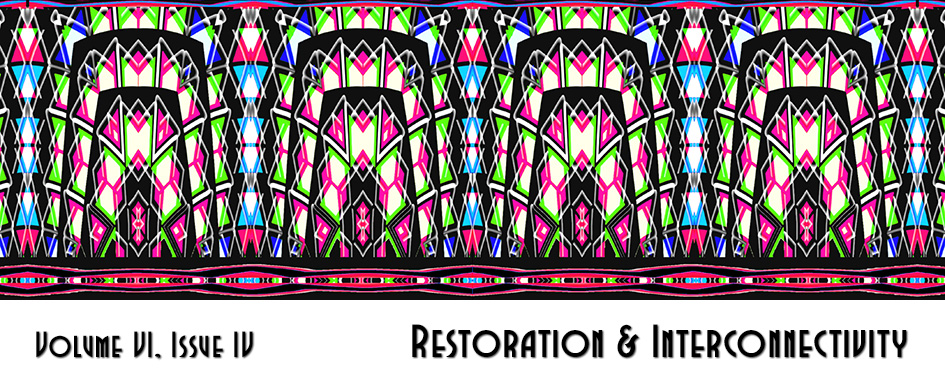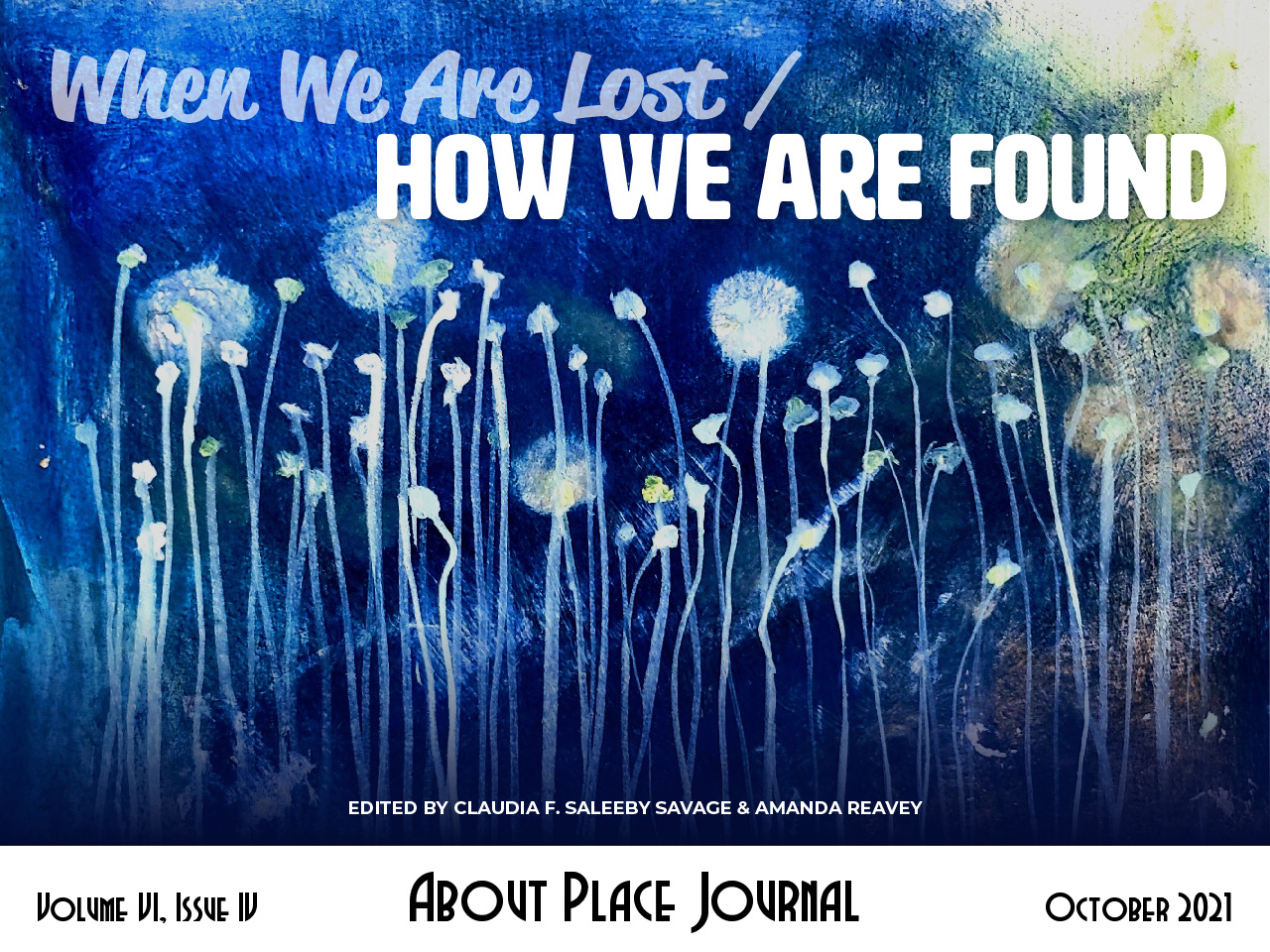Rain falls. In the cracks of the concrete floor of the basement office, rivulets rise; merge. The pooling water holds light. To step from one place to another is to ripple the picture. To drop a towel is to watch its color change. Fluffy turquoise to soaked gray-blue. Soft spring green to heavy lichen.
My husband and I drag boxes into the playroom. But we cannot save everything. The floodwaters surge through two old laptops, stealing their memories. Art made by our daughters blurs. Stick figures stick together. Saturated blues wash over delicate yellows and pinks.
We don’t have enough towels.
We call our mothers. We tell them, This is our worst flood ever.
*
We’ve had occasional puddles under our desks over the last decade, but not liquid flowing up out of the concrete. It’s never been like this.
Climate change?
Underground springs, suddenly flush?
The next-door neighbors’ ongoing construction?
How we leave 2020: soaked, mopping.
Compared to my best friend Priya and her father dying from COVID-19 and my friend Ramiza dying of cancer and wildfires swallowing houses and the smoke choking whole populations of lungs, this loss barely registers.
We clean. We toss. We stay at home, where it’s safe.
We spirit treasures into the playroom, where it’s dry.
*
I choose abundance as my word for 2021. It tastes hard and bitter in the mouth, if left alone. Without context, it insists, Acquire more. Which means, to many Americans, Take more. But Dr. Robin Wall Kimmerer’s book Braiding Sweetgrass reminds me that abundance means honoring what’s already here.
Wild strawberries.
Pinecones and acorns.
Rain.
What if, instead of buying or taking, we kneel on the driveway to admire a patch of moss sending thread-like tendrils out to collect sun? We don’t need to possess to love.
What if we serve ourselves small portions of steelhead because the elderly widows across the street are hungry too? They will say yes, if we have enough to give.
What if we look at the word abundance and see the dance in it?
As we recycle once-prized school projects, now saturated and dripping from their corners, we promise our daughters, there’s more. They do not ask if we mean more of their old selves, or more art yet to make and plenty of scraps and glue and paints to make it with.
The girls sit with the plenty of our answer—having lost some, but not all.
*
We believe we’ve come through the worst: the rain gods appeased, the damage done.
We don’t evacuate the still-dry boxes and craft supplies and long-saved letters.
We don’t worry about our house being at the bottom of the hill.
Or the construction that continues next door.
We don’t call around for bids to dig a French drain.
Then we lose more, because we couldn’t imagine losing more.
*
At the beginning of the Trump administration, we said worst. We said it at the end, too, but the word referred to new outrages.
Our next basement flood comes a few weeks later. After a mob stormed the heart of our government. Before Biden’s inauguration. What comes down from the sky during this weather event pools around our house and forces its way through the fissures in the concrete floor. We hired someone to seal it years ago, but the weather doesn’t care. The ground absorbs what it can; the rest pours into our evening.
This time, rainwater fills the whole four hundred square foot office space. We roust the children from the usual bedtime routines. We don boots. Every step makes a wave. We bail and we bail and we bail.
The rain lashes the side of the house. It’s not letting up. The ShopVac we borrowed from my brother-in-law cannot keep up with nature. We pause to measure the water’s depth: one inch by my husband’s desk. Half an inch in the shallows.
We use dustpans to shovel liquid into buckets and a plastic garbage can. We take turns with the water vacuum. We borrow, at 11:30 at night, a night-owl friend’s sump pump. We pour heavy buckets of dirty water in our shower, sink, and out the back door, where we hope it will roll down the hill, away from our foundation.
We pause, again, to measure the depth, and we get the same results. Our aching arms and backs, all our dumped-out buckets, have not made any difference.
A pencil floats over to me and I laugh.
This is a story we’re living, with a beginning, a middle, and an ending.
We are bailing in the middle.
*
The next morning, puddles still there, all of our towels already soaked, I find an envelope washed up against the white board that separates the room. The letter inside is from my grandfather, dated August 1992, my name and address typewriter crisp on the envelope. The paper is soaked and stained where the ink bled, but I can still read it.
Dear Laura,
You’re closer in my mind than the distance in miles between us!
I’m very proud of you, & I appreciate that you’re a wonderful granddaughter!
With love and best wishes,
Granddad,
& Grandma too.
*
Bailing, it turns out, is the beginning of the middle of this story.
We have days more of work. We find a rhythm.
Clean.
Worry about the future of our country.
Clean.
Worry about the elderly widows across the street.
Clean.
We fill our recycling bin with ruined papers we had tried to save.
*
When I move wet-bottomed boxes of books to reach the skinny closet in the far corner, I find a rectangular object wrapped in plastic. The bag is open on the bottom. I peel back the dripping outer layer and find a framed Roger Tory Peterson print. Meal Time, No. 104, rose-breasted grosbeak. Copyright 1942, Quaker State Lithographic Company.
This print used to hang in my grandparents’ house, first in New Jersey and then in Florida. A prized possession. My grandfather loved birds. He hid with me in a blind in a park once, so we could watch. He built purple martin houses and waited all year for them to come.
A legacy, because the pearls my grandmother gave me were stolen from my parents’ house before I had a house of my own.
The top half of the Roger Tory Peterson print holds the ugly stain of my failure to protect it.
Why didn’t I hang it on the wall the day my parents brought it out to Oregon?
Why did I put it in the basement closet?
Who turned it upside down?
Like a birdcall: did I-did I-did I?
*
I’m the worst, I’ve told myself over the years. This time, I don’t say it, because I have not been spreading lies, I have not incited a riot. There is no comparing an accident, a mistake, to the intentional violence of Trump’s administration. The shame lingers, though. I should have been paying more attention. My grandfather’s letter, now dry enough to set on my desk, offers solace when I cannot be kind to myself.
You’re a wonderful granddaughter! in blue pen, in cursive, written while his beloved wife was dying of cancer. She couldn’t sign it, so he added her name.
(& Grandma too.)
With this rediscovered note, my grandfather has forgiven me.
Abundance is saving a letter for thirty years and finding it washed up on the white board when you need it.
*
I’ve been making art since my friends died last spring. I draw and write and doodle. Ink on paper. Paint on brushes. Cut out words and images for collages. Penciled cartoons. Zines.
Art is a way of creating abundance during months of strict quarantine. It doesn’t feel safe to go out in the world for new materials, but we have scraps, magazines to cut, colored pencils, and paint. I organize what we have and call it plenty.
In sending original work to friends and family, I am atoning. For the Valentine’s card I bought for Priya and forgot to send. There is no later. For not opening the last package Ramiza sent to me, wanting to keep the conversation going. I cannot reply to her now.
Not all your friends are dead, my youngest told me when I couldn’t stop crying last spring, and it’s true, because one of my friends has been painting rainbows with unlikely colors and now I want to paint rainbows too.
*
The frame of my grandfather’s print has a maker’s stamp on the back. John Nighland, art dealer, Montclair, New Jersey. $200. Original art can be salvaged by expert restorers, but a lithograph? Even if it’s possible, it’s probably out of my price range.
I love the frame, though. Soft green and gold, like one of my grandmother’s elegant suits. Only part of the original image is ruined. The rose-breasted grosbeak of the title tilts toward a dangling currant. If I cut away the ruined bird above her, then scissor-trim around the water-ravaged branches, I might save what’s left. Or fill the space with something new. I am not a Roger Tory Peterson kind of artist. But I can cut out words and paste them in, or fill the gash with a rainbow made of different shades of yellow.
Or what if I pull off the brown paper on the back of the frame, lift the print off the glass, and rip the wrecked part away? Leave the paper tear to celebrate what’s left behind after the damage is done.
Aren’t ruined things abundance, still?
You’re closer in my mind, I want to tell my grandfather now, than the distance in miles between us.
Discussion questions:
- Consider the idea of ruin and repair. Our consumer society encourages replacement; if a household appliance fails, or if a piece of clothing gets a stain or a hole, advertisements tell us what to do: buy a new one. This year, during distance learning, my eighth grader studied global production, food sources, and the high cost of fast fashion. Every student received an embroidery kit and an expert in sustainable fashion taught them fabric repair techniques that incorporated design and personal taste. Repair doesn’t have to be invisible; it can be artistic and creative and a marker of your commitment to sustainable living. What can you repair around your place of residence—not just to fix it, but to make it more interesting than before?
- What art, letters, cards, or other ephemera have you held on to over the years? How do the things you’ve kept speak to your present, not just your past? What if we subvert our thinking about “saving”—for later, for emergencies, for the next generation—and instead apply the idea of reuse right now? Consider choosing something out of your saved pile of paper and turning it into something new. Frame a sweet note from a dear friend for the wall. Turn a romantic letter from a first love into the backdrop for a painting. Cut out elements from a few cards and collage them into something new. Take some of your now-useless business cards from past jobs and draw on the backs. What can playing with these pieces of your past teach you about how far you’ve come?


